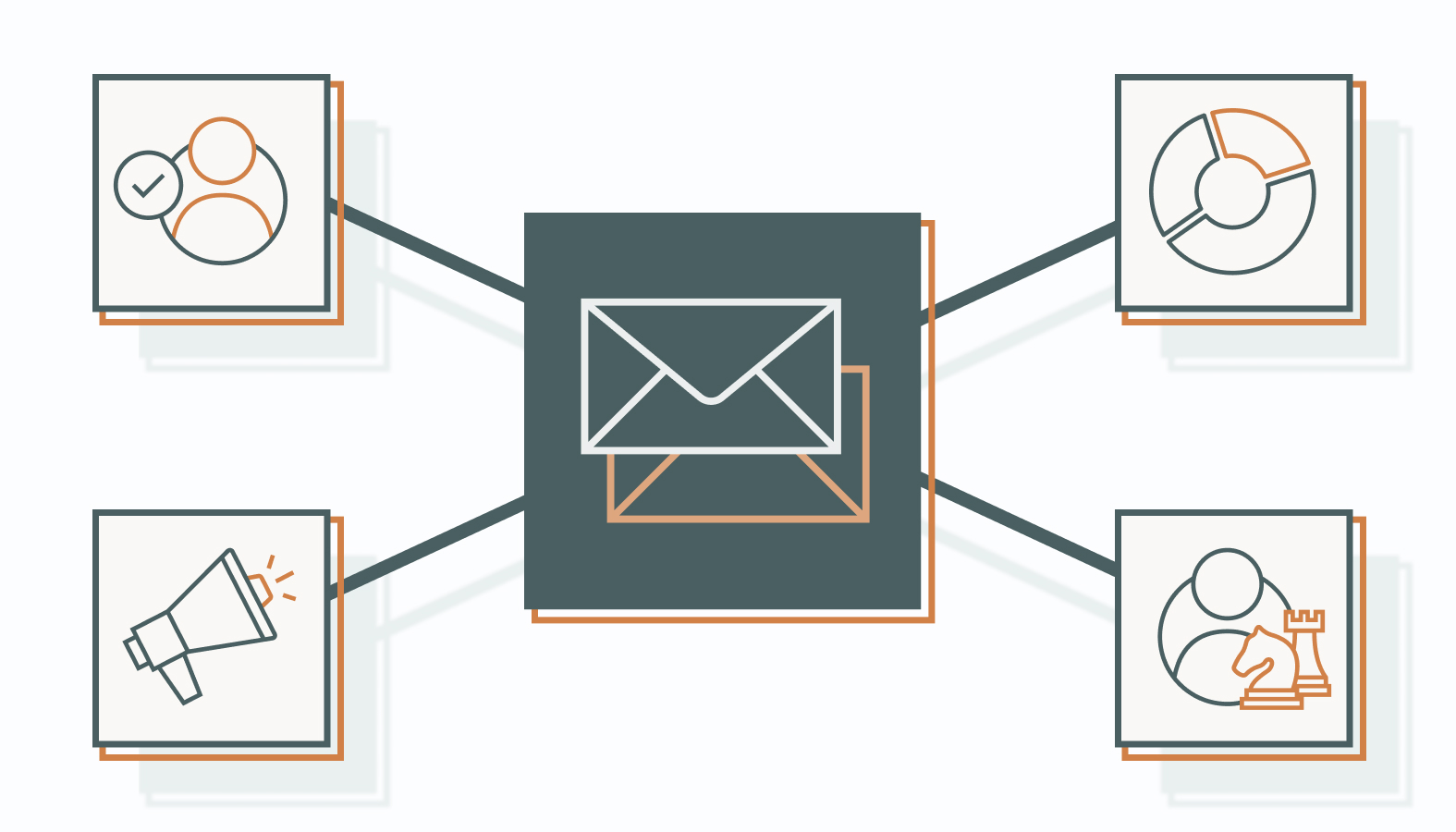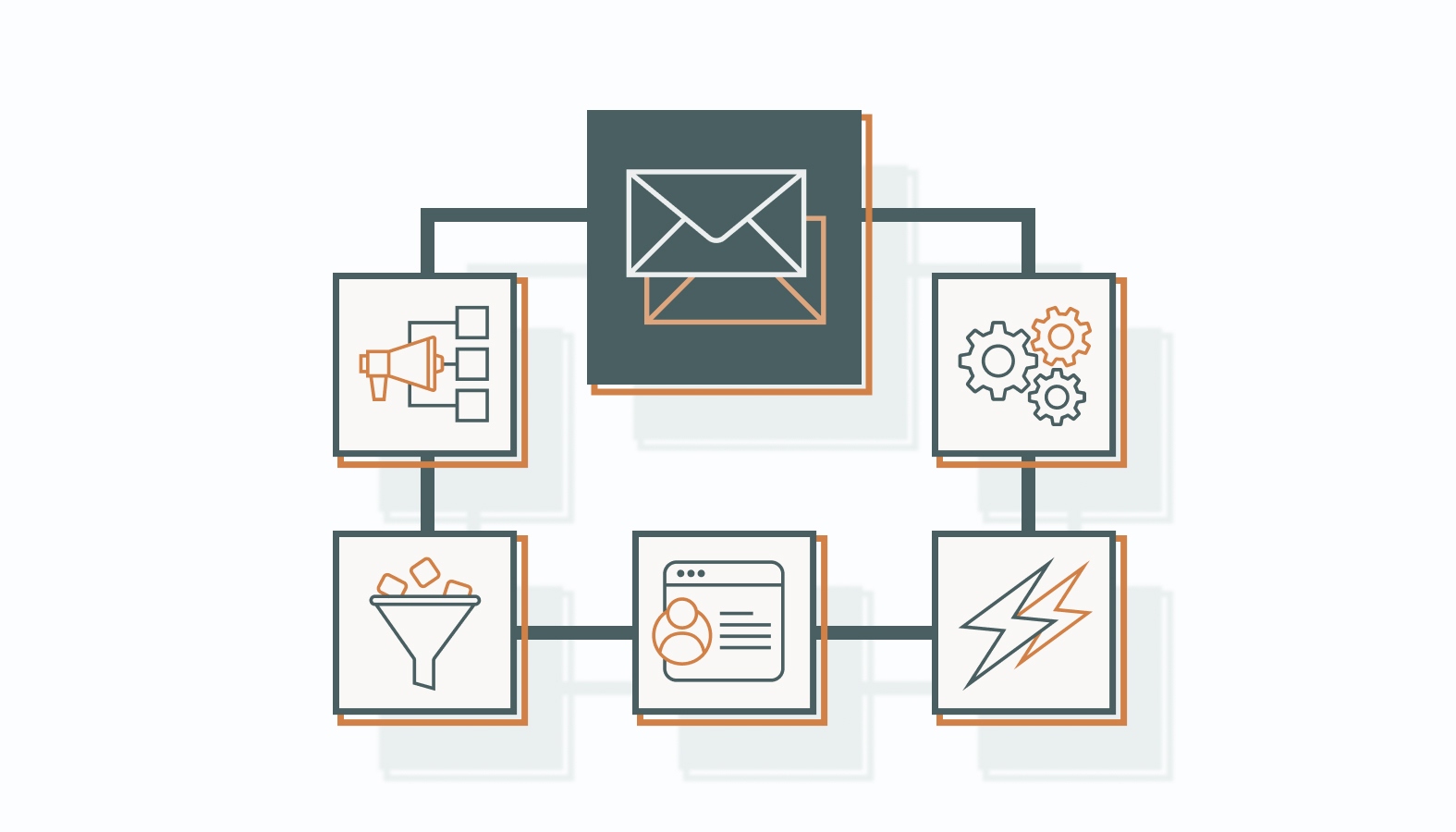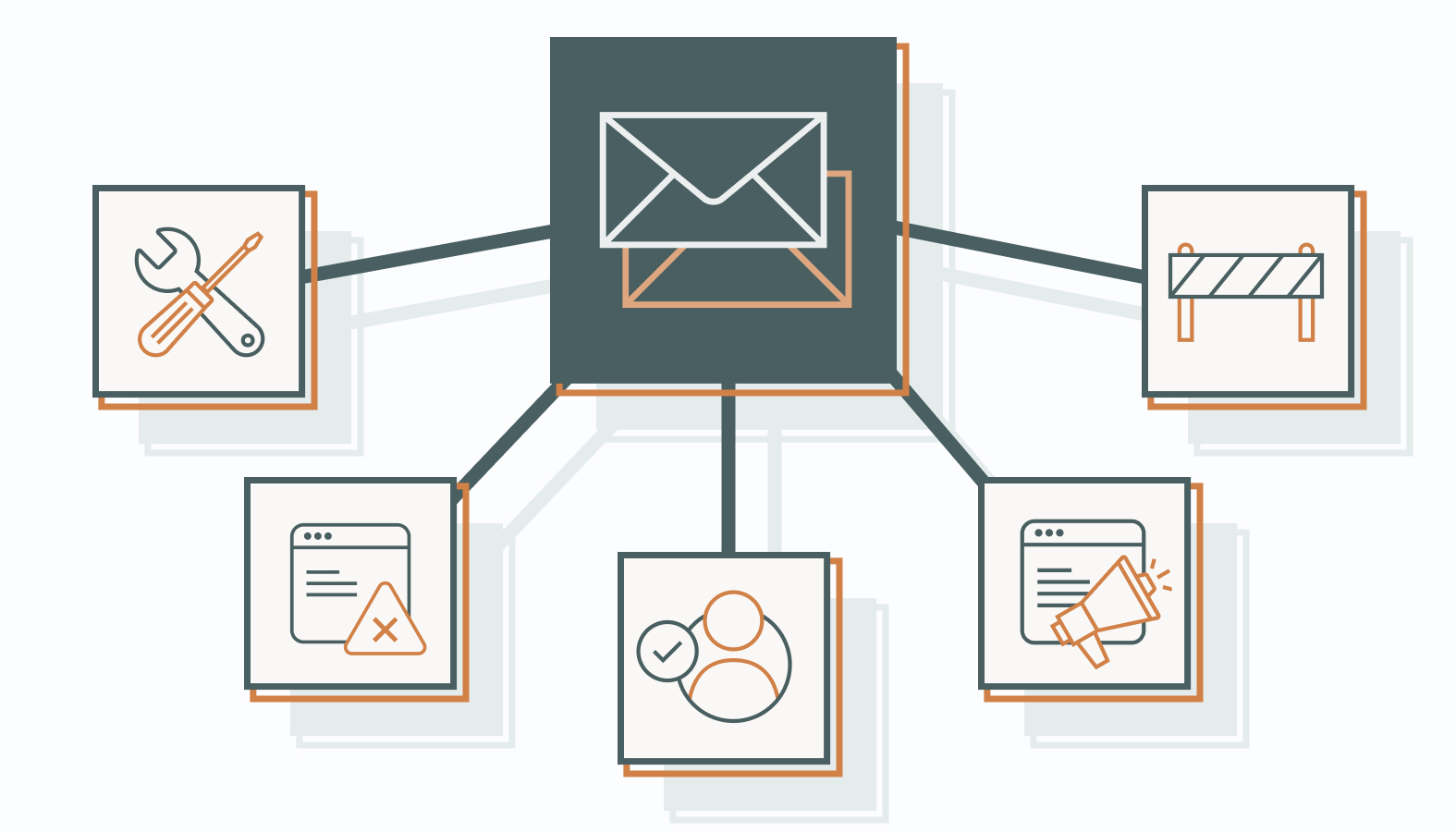If you’ve ever wondered how some brands always seem to send the right message at the perfect time, chances are they’re not doing it manually — they’re using email automation. And if you’re not, you’re leaving time, revenue, and customer relationships on the table.
Email marketing automation turns reactive outreach into a proactive growth engine. It streamlines communication, personalizes the customer experience, and frees up your team to focus on big-picture strategy. Whether you’re running a lean startup or managing a growing enterprise, automation gives your emails more impact with less effort.
In this guide, you’ll learn exactly how email marketing automation works, what types of emails drive results, and how to build smart systems that grow with your business. Let’s break it down.
Beyond Manual Marketing: How Email Marketing Automation Works
Are you a small business owner constantly juggling tasks, wishing you had more hours in the day to connect with customers? Or perhaps you’re a startup aiming to scale your outreach without hiring a huge marketing team?
Email automation is your secret weapon. It seriously upgrades your marketing strategy, boosts efficiency, sharpens your targeting, and ensures timely communication, all without constant micromanagement. By eliminating repetitive tasks, your team can focus on strategic initiatives that drive growth.
So, how does it actually work?
Email marketing automation uses smart platforms to dispatch emails automatically based on specific triggers. These “triggers” are actions your customers take (or don’t take) or specific moments in time. This allows your brand to interact with your audience at precisely the right moment, sidestepping the delays and inconsistencies of manual outreach.
Think of it like this:
- Behavior-Based Triggers: Someone signs up for your newsletter, downloads an e-book, views a specific product, or leaves items in their shopping cart.
- Time-Based Triggers: It’s their birthday, an anniversary with your brand, or a set number of days after their last purchase.
When paired with tools like a CRM (Customer Relationship Management system) or social media schedulers, email automation becomes the connective tissue that creates a fully synchronized marketing engine for your business.
Let’s take lead nurturing as a simple example. You can set up an email sequence that automatically goes out when someone subscribes to your newsletter or downloads a resource. Each message in the sequence adapts to the user’s actions or preferences, delivering content that gently guides them closer to making a purchase. There’s no guesswork or wasted effort, just precise, relevant communication that consistently performs.
Types of Automated Emails
Email automation isn’t one-size-fits-all. Each type plays a distinct role in the customer journey, helping you connect at key moments:
- Welcome Sequences: The digital handshake. These emails greet new subscribers, set expectations, introduce the brand, provide value immediately, and give recipients a reason to stick around.
- Cart Abandonment Emails: Sometimes, people need a reminder or a gentle nudge. Sent when items are left in customer carts, these emails recover missed revenue with simple, effective reminders.
- Re-engagement Campaigns: Subscribers go quiet until you give them a reason not to. These emails aim to revive dormant contacts by offering fresh content, exclusive deals, or product updates worth their attention.
- Post-Purchase Follow-ups: The sale isn’t the end but the beginning. These emails thank customers, suggest complementary products, and gather feedback. Done well, they turn one-time buyers into repeat customers.
- Birthday or Anniversary Emails: Everyone likes to feel special. These automated messages celebrate personal milestones with a personal touch, often with a discount or gift that builds goodwill and drives conversions.
Each of these automated flows supports a different stage in the buyer lifecycle. Welcome sequences boost initial engagement. Cart abandonment emails reclaim potential sales. Re-engagement campaigns restore interest and retention. Post-purchase follow-ups deepen loyalty. Milestone messages add a human touch at scale.
Together, they form a comprehensive system that nurtures relationships and maximizes customer lifetime value.
Maximizing Impact with Email Marketing Automation
Automation should do more than run in the background — here’s how to make it work harder (and smarter) for you.
Precision Targeting with Personalized Content
The power of email marketing automation lies in crafting content that speaks directly to individual users at scale.
By tapping into behavioral data like purchase history, browsing behavior, and past interactions, marketers can build emails that feel more like conversations than campaigns.
Say an ecommerce brand tracks a shopper’s purchase of running shoes. With automation, it can queue up an email suggesting running socks, hydration gear, or a training guide, exactly when the customer is likely to consider it. One retailer using this approach saw a 20% conversion increase and a notable boost in customer satisfaction, illustrating the impact of timing and relevance.
Operational Efficiency Without Compromise
Automation replaces repetitive tasks like manual segmentation or scheduling. As a result, it allows teams to focus on the strategic layer: creative, optimization, and channel expansion.
Visualize a team once bogged down in list management. With automation, they now build dynamic audiences in real time based on customer behavior, resulting in smarter workflows, faster pivots, and higher-performing campaigns.
Driving Retention with Consistent, Meaningful Touchpoints
Consistent communication builds trust. Automation helps brands maintain that consistency while making every touchpoint feel intentional.
A noteworthy example is a subscription company that triggered milestone emails, like anniversaries, usage recaps, or special member perks. These moments weren’t just nice gestures but strategically reinforced loyalty, leading to a 30% renewal rate increase and stronger long-term customer relationships.
Data That Informs Smarter Strategy
Every click, open, and conversion is a data point sharpening your strategy. Email marketing automation measures, learns, and adapts.
By analyzing performance metrics like open rates by time of day or click-throughs by content type, marketers can continually refine their campaigns. One brand noticed a midweek engagement spike and adjusted its cadence accordingly, leading to a stronger performance with zero added cost.
Data-backed decisions move marketing from guesswork to growth. Automation platforms provide the kind of granular insights that marketers used to dream about. Now, they’re standard and essential.
Selecting the Best Email Automation Solution for Your Needs
Picking the right email automation platform significantly impacts how well your marketing aligns with business goals. With countless tools competing for attention, clarity on capabilities and fit is everything.
The ideal solution elevates your marketing from transactional to transformational through efficiency, personalization, and scale.
ActiveCampaign
- Best for: Small to mid-sized teams needing enterprise-grade automation without the overhead
ActiveCampaign is for businesses that want more than basic automation — they want intelligent tools that power savvier marketing. It shines when building complex workflows and reaching the right people at the right time.
With ActiveCampaign, you can design highly personalized campaigns based on behaviors, preferences, or lifecycle stages, which helps turn engagement into long-term loyalty.
If your strategy relies on nurturing relationships with targeted messaging, ActiveCampaign is worth a serious look.
GetResponse
- Best for: Marketers combining email and webinar strategies
GetResponse excels with built-in webinar hosting and strong analytics, which is ideal for teams looking to streamline lead generation from event invitations to post-event follow-up.
The platform also supports multi-channel campaigns, including SMS, landing pages, and social ads, allowing for cohesive and consistent customer journeys. Its performance insights help marketers fine-tune strategies confidently, making it a wise choice for businesses scaling across multiple touchpoints.
SendInblue (Brevo)
- Best for: SMBs needing cost-effective, multi-channel communication
Formerly SendInblue, Brevo offers versatile features like SMS marketing and transactional email capabilities. This platform is particularly appealing for its comprehensive yet straightforward approach to marketing automation. It allows companies to engage customers through multiple channels, ensuring broader reach.
Brevo’s standout feature is its pricing model, which is highly accessible for small to medium-sized businesses. It provides excellent value for those seeking to maximize their marketing budget without compromising quality or features.
Salesforce Marketing Cloud
- Best for: Large organizations with complex, data-driven strategies
Salesforce Marketing Cloud is built for scale, offering robust tools for orchestrating complex, multi-channel marketing strategies.
Deep CRM integration empowers teams to leverage real-time customer data across every touchpoint: email, mobile, ads, and more. This unified data environment enables highly personalized, data-driven campaigns and precise audience targeting.
For enterprise organizations managing large volumes of customer interactions, Salesforce Marketing Cloud delivers the control and intelligence needed to execute at a high level.
Adobe Marketo Engage
- Best for: B2B teams focused on lead nurturing and ABM
Adobe Marketo Engage stands out for its powerful lead management and account-based marketing capabilities, making it a strong choice for B2B organizations with long sales cycles and complex buyer journeys. Its comprehensive analytics and reporting tools offer a granular view of performance, enabling data-backed decisions to drive results.
Whether you’re fine-tuning lead-nurturing workflows or scaling ABM efforts, Marketo offers the insights and flexibility to maximize ROI across every stage of the funnel.
Implementing Effective Email Marketing Automation Strategies
Email automation elevates engagement, drives conversions, and keeps your brand top-of-mind without burning out your team. The key lies in strategy, not just selecting which tool you choose, but leveraging it to deliver value at scale.
Here’s how to approach automation with precision and purpose.
1) Choose the Right Email Automation Platform
The platform you choose sets the stage for everything. Prioritize tools that balance functionality with usability. You’ll need advanced segmentation, real-time analytics, personalization capabilities, and seamless integrations with your CRM and other systems.
Avoid bloated platforms that require weeks of onboarding. Your team should be able to build, launch, and iterate constantly without calling in tech support. Look at scalability, too, as your email system should grow with you, not bottleneck six months down the line.
While cost matters, consider ROI instead of the sticker price. A platform that increases engagement by even a few percentage points could pay for itself quickly.
2) Build and Segment a High-Intent Email List
Quality beats quantity every time. Focus on permission-based opt-ins; these are people who actually want to hear from you. Use strategic lead magnets, gated content, or onboarding forms to grow your list the right way.
Once you have a solid list, segment it expertly. Go beyond demographics — slice by behavior, purchase history, content engagement, and lifecycle stage. A well-segmented list allows you to craft messages that feel one-on-one, not one-size-fits-all.
Compliance isn’t optional, either. Staying aligned with GDPR, CAN-SPAM, and other data privacy regulations protects your brand and builds trust with subscribers.
3) Map Out Smart Automation Workflows
Every automated workflow should mirror a part of your customer journey. Start with high-impact flows: welcome series, cart abandonment, re-engagement, post-purchase, and lead nurturing.
A welcome sequence should do more than say “hi.” Use it to establish value, showcase your brand, and guide new contacts to the best action, whether a content resource, demo, or product page.
Lead nurturing flows, on the other hand, should educate and qualify. They should address pain points, offer solutions, and build momentum toward a conversion without being pushy. Each touchpoint should be intentional and data-informed.
4) Craft Content That Converts
Automation without compelling content is just noise. Write subject lines that stand out in crowded inboxes. Get to the point fast, use visuals strategically, and always include a clear call to action.
Personalization is more than dropping in a first name. Use behavioral data to serve content that aligns with individual interests, needs, or stages in the funnel. Dynamic content blocks let you tailor sections of your email based on user data, keeping the message relevant and timely.
Great content respects the reader’s time and delivers value with every send.
5) Track, Test, and Optimize
Automation isn’t a set-it-and-forget-it game. You must monitor performance and adjust constantly. Watch your open rates, click-through rates, conversion rates, and unsubscribes. These metrics tell the real story.
A/B test subject lines, email copy, visuals, send times, and CTAs. Test one variable at a time for clean data. Use heatmaps and click maps to see how people interact with your content. Then, act on what you learn.
Refine workflows, adjust timing, and update segmentation logic. Email automation should evolve with your audience, not trail behind them.
Overcoming Common Challenges in Email Automation
Email automation is powerful, but it’s not plug-and-play. From deliverability issues to data compliance and technical roadblocks, each challenge can derail results if left unchecked.
Here’s how to identify and address the most common hurdles before they compromise your campaigns.
Maintaining Reliable Email Deliverability
Even the best emails are worthless if they never reach the inbox. Deliverability depends on sender reputation, list hygiene, authentication protocols (like SPF, DKIM, and DMARC), and consistent engagement.
Start by cleaning your email list regularly. Remove hard bounces, inactive contacts, and non-responders who haven’t engaged in the past 90 days. Use double opt-in methods to ensure you’re reaching people who actually want to hear from you. Segment your audience by behavior or lifecycle stage so each message lands purposefully, not as noise.
Monitor your sender reputation using tools like Google Postmaster Tools or Microsoft SNDS. If your emails are underperforming, test smaller segments before rolling out complete sends, and avoid sending from new or untrusted IP addresses without warming them up properly.
Avoiding Spam Triggers
Spam filters use sophisticated algorithms to flag emails that feel off—too promotional, too image-heavy, or just poorly constructed. Being flagged means fewer eyeballs and lower ROI.
Use a consistent sender name and verified domain. Keep your copy clean: no misleading subject lines, no shouting in ALL CAPS, and no excessive exclamation points. Maintain a healthy balance of images and text, and always include a visible unsubscribe link. That link isn’t just a best practice but a deliverability safeguard. If users can’t find it, they’ll mark you as spam instead.
Handling Customer Data with Precision
Privacy regulations like GDPR, CAN-SPAM, and CCPA aren’t optional. Mishandling customer data can get expensive fast, not to mention damaging to your brand.
Get explicit permission before sending marketing emails. Make your opt-ins clear and purposeful, not buried in fine print. Keep privacy policies updated, accessible, and transparent about what data you collect and how you use it. Train your team on compliance—not just the legal team, but everyone involved in data handling or campaign execution.
Use permission-based fields in your CRM, and set clear rules for data access. When in doubt, over-communicate your data usage policies to subscribers.
Creating High-Impact, Relevant Content
No automation tool can fix weak content. If your emails don’t resonate, no level of segmentation or frequency control will save them.
Use behavioral data and user preferences to personalize messages at scale. Dynamic content blocks can adapt per recipient, showing only what’s most relevant. Lean into storytelling techniques, embed interactive elements when appropriate, and use real-time content (like live product inventory or countdown timers) to drive urgency and interest.
Always A/B test subject lines, CTA placement, and layout. But don’t stop there: collect post-campaign feedback through short surveys or embedded polls to find out why people clicked or didn’t. The more you understand your audience’s response, the sharper your next campaign becomes.
Navigating Technical and Resource Constraints
Tech limitations and resource gaps are common blockers, especially for lean teams or growing businesses trying to scale quickly.
Start by identifying your automation priorities. Focus first on workflows with high ROI: welcome sequences, cart abandonment flows, post-purchase follow-ups, and re-engagement campaigns. Use your platform’s built-in features to their full extent before stacking new tools on top. Most companies use only a fraction of their marketing automation software’s capabilities.
If bandwidth is limited, invest in training your team. Building internal expertise pays dividends over time, allowing you to iterate faster and respond more effectively to campaign insights.
Turn Email Automation into Momentum
Email automation can transform your marketing into an engine running at full speed. When strategy leads the way, automation becomes a powerful tool for scaling communication, nurturing leads, and turning customer actions into meaningful outcomes.
From selecting the right platform to crafting hyper-relevant content, success depends on aligning your tools, workflows, and messaging with real-world behavior. Whether you’re recovering abandoned carts, re-engaging quiet subscribers, or delivering perfectly timed product suggestions, the result is marketing that feels personal because it is.
When timing, relevance, and scale are everything, smart automation gives you the edge. It helps you make a bigger impact, stay better connected, and be ready for growth.
Let’s Talk Strategy
Every business has its own marketing challenges, and automation should solve them, not add to them. If you’re still figuring out how to make these tools actually work for your goals, we’re here to help.
Ready to simplify your strategy and amplify your results? Schedule a candid conversation with one of our experts. We don’t just recommend platforms. We dig into your unique situation, help you build smart workflows, and show you how to turn automation into measurable growth. No pitch — just an honest discussion about your next best move.









